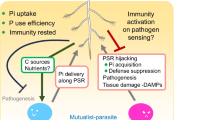Abstract
The use of bioluminescence was evaluated as a tool to study Pseudomonas syringae population dynamics in susceptible and resistant plant environments. Plasmid pGLITE, containing the luxCDABE genes from Photorhabdus luminescens, was introduced into Pseudomonas syringae pv. phaseolicola race 7 strain 1449B, a Gram-negative pathogen of bean (Phaseolus vulgaris). Bacteria recovered from plant tissue over a five-day period were enumerated by counting numbers of colony forming units and by measurement of bioluminescence. Direct measurement of bioluminescence from leaf disc homogenates consistently reflected bacterial growth as determined by viable counting, but also detected subtle effects of the plant resistance response on bacterial viability. This bioluminescence procedure enables real time measurement of bacterial metabolism and population dynamics in planta, obviates the need to carry out labour intensive and time consuming traditional enumeration techniques and provides a sensitive assay for studying plant effects on bacterial cells.
Similar content being viewed by others
References
Figurski DH, Helinski DR (1979) Replication of an origin-containing derivative of plasmid RK2 dependent on a plasmid function derived in trans Proceedings of the National Academy of Sciences of the USA 76: 1648–1652
Greer LF, III, Szalay AA (2002) Imaging light emission from the expression of luciferases in living cells and organisms: a review Luminescence 17: 43–74
Jackson AO, Taylor CB (1996) Plant–microbe interactions: Life and death at the interface The Plant Cell 8: 1651–1668
King EO, Ward MK, Raney DE (1954) Two simple media for the demonstration of pyocyanin and fluorescin Journal of Laboratory and Clinical Medicine 44: 301–307
Kovach ME, Phillips RW, Elzer PH, Roop RM, II, Peterson KM (1994) pBBR1MCS: A broad-host-range cloning vector Biotechniques 16: 800–802
Kovach ME, Elzer PH, Hill DS, Robertson GT, Farris MA, Roop RM, II, Peterson KM (1995) Four new derivatives of the broad-host-range cloning vector pBBR1MCS, carrying different antibiotic-resistance genes Gene 166: 175–176
Marincs F, White DWR (1994) Immobilization of Escherichia coli expressing the lux genes of Xenorhabdus luminescens Applied and Environmental Microbiology 60: 3862–3863
Marques CN, Salisbury VC, Greenman J, Bowker KE and Nelson SM (2005) Discrepancy between viable counts and light output as viability measurements, following ciprofloxacin challenge of self-bioluminescent Pseudomonas aeruginosa biofilms. Journal of Antimicrobial Chemotherapy 56: Advance Access published online
Meighen EA, Szittner RB (1992) Multiple repetitive elements and organization of the lux operons of luminescent terrestrial bacteria Journal of Bacteriology 174: 5371–5381
Parveen A, Smith G, Salisbury V, Nelson SN (2001) Biofilm culture of Pseudomonas aeruginosa expressing lux genes as a model to study susceptibility to antimicrobials FEMS Microbiology Letters 199: 115–8
Salisbury V, Pfoestl A, Wiesinger-Mayr H, Lewis R, Bowker KE, MacGowan AP (1999) Use of a clinical Escherichia coli isolate expressing lux genes to study the antimicrobial pharmacodynamics of moxifloxacin Journal of Antimicrobial Chemotherapy 43: 829–832
Sambrook J, Fritsch EF and Maniatis T (1989) Molecular cloning: A laboratory manual. In: Nolan C (ed.) 2nd edn. Cold Spring Harbor Laboratory Press, New York
Shaw JJ, Kado CI (1986) Development of a Vibrio bioluminescence gene-set to monitor phytopathogenic bacteria durin the ongoing disease process in a non-disruptive manner Biotechnology 4: 560–564
Shaw JJ, Dane F, Geiger D, Kloepper JW (1992) Use of bioluminescence for detection of genetically engineered microorganisms released into the environment Applied and Environmental Microbiology 58: 267–273
Vivian A, Atherton GT, Bevan JR, Crute IR, Mur LAJ, Taylor JD (1989) Isolation and characterization of cloned DNA conferring specific avirulence in Pseudomonas syringae pv. pisi to pea (Pisum sativum) cultivars, which possess the resistance allele, R2 Physiological and Molecular Plant Pathology 34: 335–344
Acknowledgements
We thank Steven Beard, Alan Vivian and Gillian Smith for helpful discussions. Work with the plant pathogen was carried out under MAFF licences PHL63A/3235 and PHL63A/3236.
Author information
Authors and Affiliations
Corresponding author
Rights and permissions
About this article
Cite this article
Paynter, C.D., Salisbury, V.C., Arnold, D.L. et al. The Use of Bioluminescence for Monitoring in planta Growth Dynamics of a Pseudomonas syringae Plant Pathogen. Eur J Plant Pathol 115, 363–366 (2006). https://doi.org/10.1007/s10658-006-9018-3
Accepted:
Published:
Issue Date:
DOI: https://doi.org/10.1007/s10658-006-9018-3




